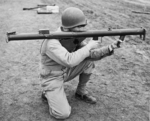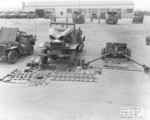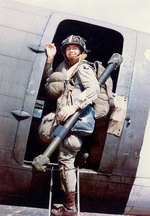M1/M9 'Bazooka' Launcher
| Country of Origin | United States |
| Type | Launcher |
| Caliber | 57.000 mm |
| Length | 1.370 m |
| Weight | 5.900 kg |
| Ammunition Weight | 1.59 kg |
| Rate of Fire | 5 rounds/min |
| Range | 140.000 m |
| Muzzle Velocity | 81 m/s |
Contributor: C. Peter Chen
ww2dbaseIn 1942, the US Army possessed the M10 grenade that could penetrate up to 60 millimeter of armor, but these weapons were difficult to throw by hand, and were too heavy to be launched as rifle grenades. The US Army embarked on two parallel projects, one to lessen the weight, at the cost of armor penetration, of the M10 design (which would ultimately result in the M9 grenades which could be fired from grenade launchers), and another project, led by Lieutenant Edward Uhl, aimed to use rocket propulsion to deliver M10 grenades to their targets. He came up with the shoulder-mounted launching tube design relatively quickly, presenting the original M1 launcher design and a simplified M1A1 design by the end of 1942. These launchers were nicknamed "Bazookas" for their resemblance to the brass musical instrument by the same name. The initial shells, each propelled by a solid rocket motor, were designated M6.In Europe, M1A1 launchers were first used by US forces in in the field during the Operation Torch landings in North Africa, though they contributed little to the campaign. At the same, a large number of the original M1 launchers were sent to the Soviets, and a great number were captured by the Germans. These captured units would heavily influence the later German Panzerschreck launchers. During the invasion of Sicily, Italy in 1943, small numbers of M1A1 launchers were deployed, and were credited for destroying five tanks (one being a Tiger I heavy tank, with a lucky shot through the driver's vision slot). Around the same time, the improved M9 variant design was completed, coupled with the more powerful and more reliable M6A3 rockets, to deal with the thicker armor of later German tanks.
In the Pacific, M1 and M1A1 "Bazooka" launchers were used largely against concrete bunkers and pillboxes rather than armored vehicles. It was found that they were not effective against positions constructed from coconut logs, earth, and sand, as the ammunition did not always detonate when striking the softer material.
In 1944, US Army Major Charles Carpenter, an artillery spotting pilot flying L-4H Grasshopper aircraft, mounted six "Bazooka" launchers on his aircraft. He was credited with the destruction or disabling of several tanks and armored vehicles in France in 1944. Stories such as Carpenter's exploits would eventually lead to the design of rocket-launching helicopters during the Korean War era.
In early 1945, the US Army's Chemical Warfare Service completed its M26 Gas Rocket ammunition design, which was meant to deliver shells containing the deadly chemical cyanogen chloride. These shells, designed to be fired from M9 launchers, were planned to be used against cave-hidden Japanese troops, but ultimately they were never used.
After WW2, philosophy of the "Bazooka" completely changed after observing the larger caliber German Panzerschreck, which was deemed more useful. The M20 "Super Bazooka" would see an increase in caliber from 60 to 90-millimeter, which translated to better armor penetration capabilities. Nevertheless, the older WW2 era M9 and M9A1 launchers, firing M6A3 rockets also of the WW2 era, continued to see service during the Korean War. M20 launchers would see service during the Vietnam War before being phased out by more modern anti-tank weapons.
Source: Wikipedia ww2dbase
Last Major Revision: Apr 2017
M1/M9 'Bazooka' Launcher Interactive Map
Photographs
 |  |  |  |
Please consider supporting us on Patreon. Even $1 per month will go a long way! Thank you. Please help us spread the word: Stay updated with WW2DB: |
Visitor Submitted Comments
All visitor submitted comments are opinions of those making the submissions and do not reflect views of WW2DB.
Search WW2DB
News
- » US Women's Army Corps "Six Triple Eight" Awarded with Congressional Gold Medal (30 Apr 2025)
- » Wreck of Soviet Submarine M-49 Found (10 Apr 2025)
- » Japanese Emperor Visited Iwoto (Iwo Jima) (8 Apr 2025)
- » Race, Holocaust, and African-American WW2 Histories Removed from the US Naval Academy Library (7 Apr 2025)
- » US Government Plans to Purge WW2 Information (17 Mar 2025)
- » See all news
Current Site Statistics
- » 1,167 biographies
- » 337 events
- » 44,617 timeline entries
- » 1,244 ships
- » 350 aircraft models
- » 207 vehicle models
- » 376 weapon models
- » 123 historical documents
- » 261 facilities
- » 470 book reviews
- » 28,514 photos
- » 365 maps
Famous WW2 Quote
"No bastard ever won a war by dying for his country. You win the war by making the other poor dumb bastard die for his country!"George Patton, 31 May 1944
Support Us
Please consider supporting us on Patreon. Even $1 a month will go a long way. Thank you!
Or, please support us by purchasing some WW2DB merchandise at TeeSpring, Thank you!
14 Oct 2024 05:06:54 PM
I've heard that the projectile of the bazooka struggled to penetrate even light tanks due to the fact that it was spun the projectile and that caused the copper jet to spin apart before it could penetrate all the way. Is this correct?